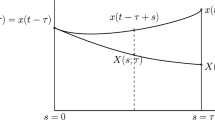Abstract
The extended McKendrick-von Foerster structured population model is employed to derive a nonautonomous ordinary differential equation model of a population. The derivation assumes that the individual life history can be delineated into several physiological stages. We study the persistence of the population when the model is autonomous and base the nonautonomous survival analysis on the autonomous case and a comparison principle. A brief excursion into alternate life history strategies is presented.
Similar content being viewed by others
References
Caswell, H.: Matrix methods and the analysis of complex plant life cycles. In: Gross, L. J., Miura, R. M. (eds.) Some mathematical questions in biology, plant biology. (Lectures on Mathematics in the Life Sciences, Vol. 18, pp. 171–233.) AMS: Providence, RI, 1986
Cushing, J. M.: Equilibria and oscillations in age-structured population growth models. In: Shukla, J. B., Hallam, T. G., Capasso, V. (eds.) Mathematical modelling of environmental and ecological systems, pp. 153–175. New York: Elsevier 1987
Frauenthal, J. C.: Mathematical modeling in epidemiology. Berlin Heidelberg New York: Springer 1980
Freedman, H. I., Waltman, P.: Mathematical analysis of some three species food chain models. Math. Biosci. 33, 257–276 (1977)
Freedman, H. I., Waltman, P.: Persistence in models of three interacting predator-prey populations. Math. Biosci. 68, 213–233 (1984)
Freedman, H. I., Waltman, P.: Persistence in a model of three competitive populations. Math. Biosci. 73, 89–101 (1985)
Gard, T. C.: Persistence in food webs. In: Levin, J. A., Hallam, T. G. (eds.) Mathematical ecology: Proceedings of the conference (Lect. Notes Biomath., vol. 54, pp. 208–219) Berlin Heidelberg New York: Springer 1984
Gard, T. C., Hallam, T. G.: Persistence in food webs: I Lotka-Volterra food chains. Bull. Math. Biol. 41, 877–891 (1979)
Gazis, D. C., Montroll, E. W., Ryniker, J. E.: Age-specific, deterministic model of predator prey populations: application to Isle Royale. IBM J. Res. Dev. 17, 47–53 (1973)
Gurney, W. S. C., Nisbet, R. M., Blythe, S. P.: The systematic formulation of models of stage-structured populations, In: Metz, J. A. J., Dekmann, O. (eds.) (Lect. Notes Biomath., vol. 68, pp. 474–494) Berlin Heidelberg New York: Springer 1986
Hallam, T. G., Lassiter, R. R., Kooijman, S. A. L. M.: Effects of toxicants on aquatic populations. Applied mathematical ecology. Berlin Heidelberg New York: Springer (1988a)
Hallam, T. G., Lassiter, R. R., Li, J., Suarez, L.: Modelling individuals employing an integrated energy response: Application to Daphnia. (To appear) (1988b)
Hallam, T. G., Ma, Z.: Persistence in population models with demographic fluctuations. J. Math. Biol. 24, 327–340 (1986)
Hallam, T. G., Ma, Z.: On density and extinction in continuous population models. J. Math. Biol. 25, 191–201 (1987)
Hastings, A.: Age-dependent predation is not a simple process. I. Continuous time models. Theor. Popul. Biol. 23, 347–362 (1983)
Hastings, A.: Interacting age structured populations. In: Hallam, T. G., Levin, S. A. (eds.) Mathematical ecology: An introduction (Biomathematics, vol. 17, pp. 286–294) Berlin Heidelberg New York: Springer 1986
Kooijman, S. A. L. M.: Population dynamics on basis on budgets. In: Metz, J. A. J., Diekmann, O., (eds.) The dynamics of physiologically structured populations (Lect. Notes Biomath., vol. 68, pp. 266–297) Berlin Heidelberg New York: Springer 1986
Kooijman, S. A. L. M., Metz, J. A. J.: On the dynamics of chemically stressed populations: the deduction of populations consequences from effects on individuals. Ecotox. Env. Saf. 8, 254–274 (1984)
Lakshmikantham, V., Leela, S.: Differential and integral inequalities, vol. I. New York: Academic Press 1969
Metz, J. A. J., Diekmann, O.: The dynamics of physiologically structured populations (Lect. Notes Biomath., vol. 68) Berlin Heidelberg New York: Springer 1986
Plemmons, R. V.: M-matrix characterizations. I. Nonsingular M-matrices. Linear Algebra Appl. 18, 175–188 (1977)
Reddingius, J.: Notes on the mathematical theory of epidemics. Acta Biotheor. 20, 125–157 (1971)
Smith, R. H., Mead, R.: Age structure and stability in models of prey predator systems. Theor. Popul. Biol. 6, 308–322 (1974)
Author information
Authors and Affiliations
Additional information
This work was supported in part by the U.S. Environmental Protection Agency under cooperative agreement CR 813353010
Rights and permissions
About this article
Cite this article
Li, J., Hallam, T.G. Survival in continuous structured populations models. J. Math. Biology 26, 421–433 (1988). https://doi.org/10.1007/BF00276371
Received:
Revised:
Issue Date:
DOI: https://doi.org/10.1007/BF00276371



